Trending ADHD Papers
Visual Abstract
Association between heavy metals exposure and risk of attention deficit hyperactivity disorder (ADHD) in children: a systematic review and meta-analysis
Heavy Metals and ADHD Risk in Children
December 9, 2024
author
Gu Q, Liu J, Zhang X, Huang A, Yu X, Wu K, Huang Y
journal
Eur Child Adolesc Psychiatry
Date Published
2024 Aug 10
Why link to a visual abstract?
What is a visual abstract?
Original
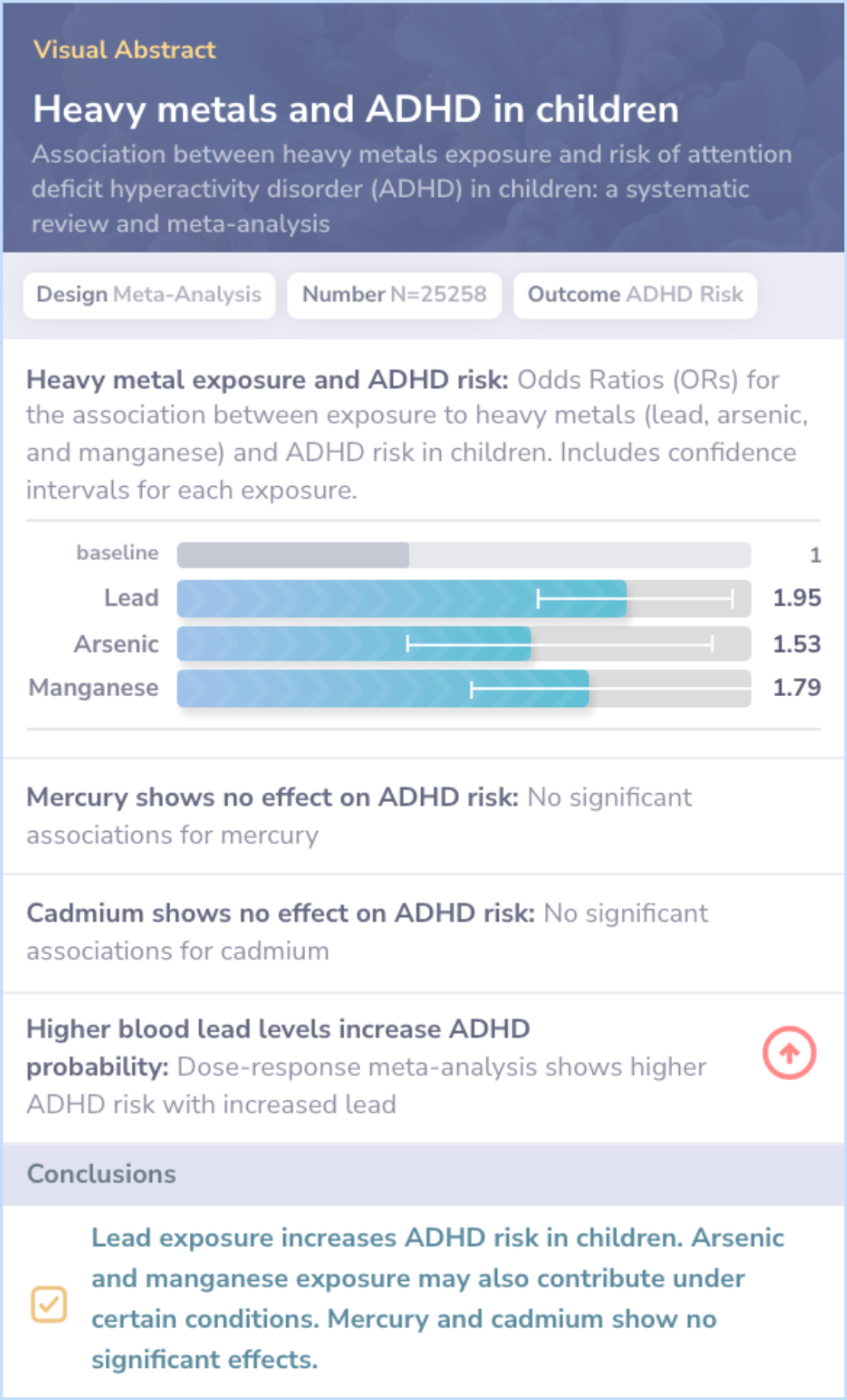
Study Summary
🔬
What They Studied
The researchers aimed to study the relationship between exposure to five common heavy metals (lead, arsenic, mercury, cadmium, and manganese) and the risk of ADHD in children.
💡
What They Found
The study found that lead exposure increases ADHD risk in children, with arsenic and manganese also showing potential associations, while no significant links were found for mercury and cadmium.
📚
What This Means
The findings align with current evidence that lead exposure is a significant risk factor for ADHD in children, suggesting arsenic and manganese may also play a role under certain conditions.
Study Overview
Background & Objectives
Attention Deficit Hyperactivity Disorder (ADHD) affects many children globally, often treated with medications like methylphenidate. However, researchers are exploring environmental factors that could influence ADHD development, focusing on heavy metals.
Recent studies have probed the link between exposure to heavy metals such as lead, arsenic, mercury, cadmium, and manganese, and the risk of ADHD in children, to better understand potential neurodevelopmental impacts.
Recent studies have probed the link between exposure to heavy metals such as lead, arsenic, mercury, cadmium, and manganese, and the risk of ADHD in children, to better understand potential neurodevelopmental impacts.
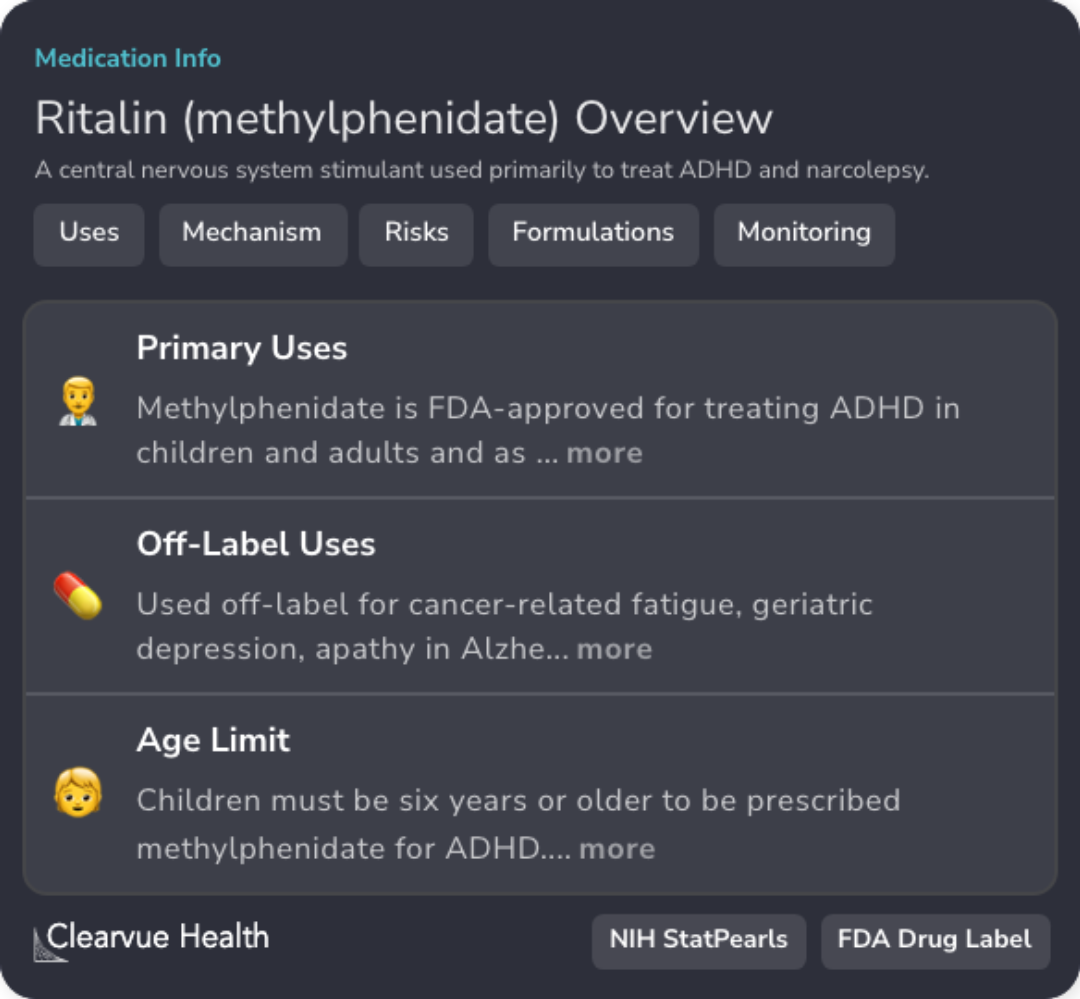
Abstract: background
Heavy metals can negatively affect children's neurodevelopment, yet the relationship between heavy metals exposure and attention defici...more
Study Summary
Methods
The researchers delved into existing scientific research by exploring big databases like PubMed and Web of Science until early 2024. They gathered data from 31 different studies, involving over 25,000 children, to analyze the potential link between heavy metal exposure and ADHD.
By combining data from various studies, the researchers aimed to get a clearer picture of any significant patterns linking these toxic metals to ADHD risk.
By combining data from various studies, the researchers aimed to get a clearer picture of any significant patterns linking these toxic metals to ADHD risk.

Abstract: methods
Online databases of PubMed, Web of Science, and Embase were searched before February 29, 2024. A total of 31 studies involving 25,258 c...more
Study Results
Results
The study found that lead exposure is linked with a higher risk of ADHD in children, especially noticeable in American regions. This means kids exposed to more lead may be nearly twice as likely to develop ADHD. For arsenic and manganese, some analyses showed a positive link to ADHD, mainly when certain studies were excluded.
However, mercury and cadmium didn't show significant connections. Higher blood lead levels could further increase ADHD chances, signaling a dose-related response: the more exposure, the higher the risk.
However, mercury and cadmium didn't show significant connections. Higher blood lead levels could further increase ADHD chances, signaling a dose-related response: the more exposure, the higher the risk.
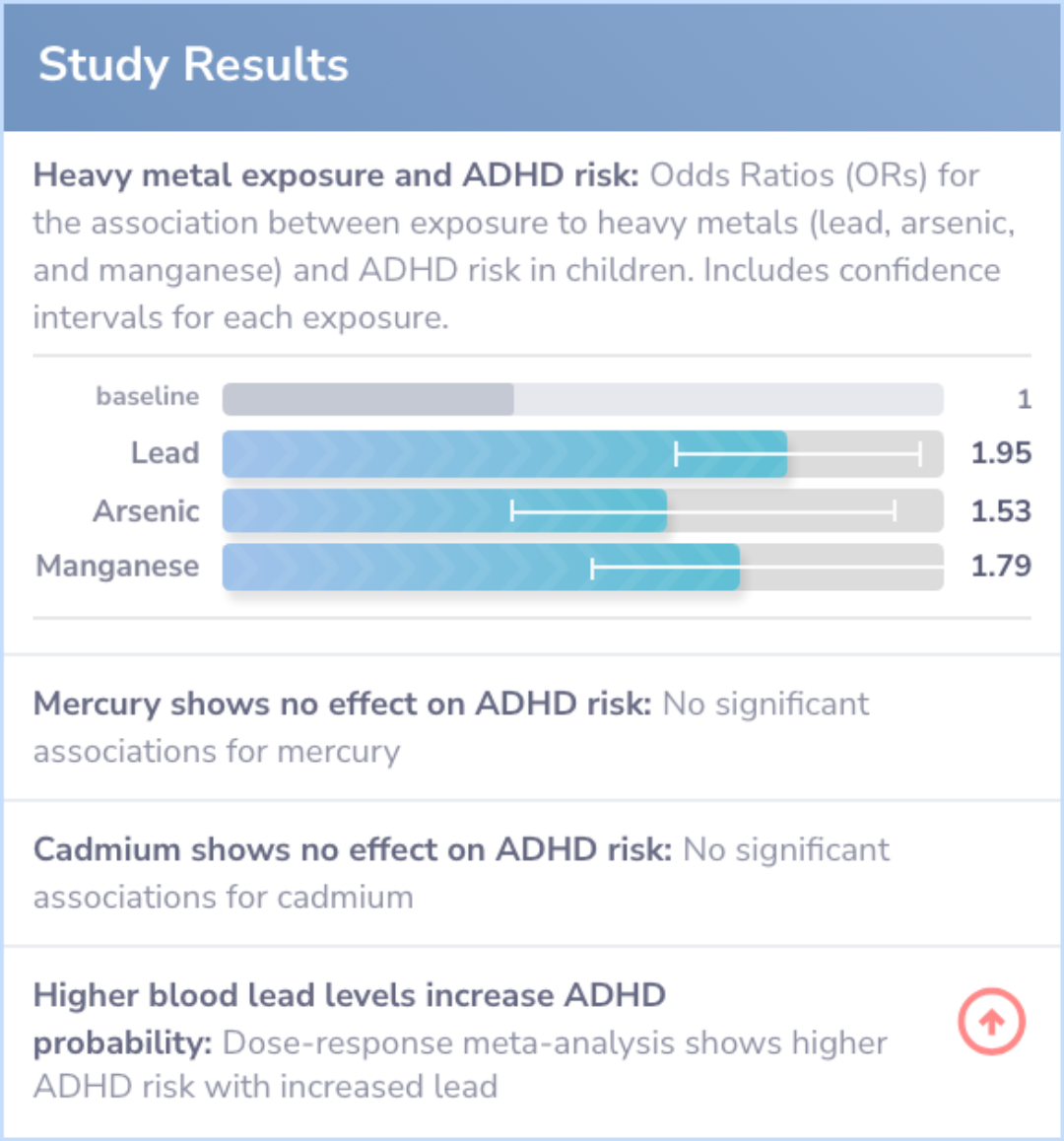
Abstract: results
Our findings revealed that lead exposure was positively associated with ADHD risk in children (OR = 1.95, 95% CI: 1.57-2.41) overall, w...more
Study Summary
Conclusions
Lead exposure consistently appears to raise ADHD risk in children, underscoring the need for continued monitoring and prevention. Arsenic and manganese might also be linked with ADHD, though more research is needed to confirm these findings across different scenarios.
Future studies should look at how various levels of heavy metal exposure impact ADHD, especially in areas less impacted by these pollutants, to fully understand their effects.
Future studies should look at how various levels of heavy metal exposure impact ADHD, especially in areas less impacted by these pollutants, to fully understand their effects.
Abstract: conclusions
Lead exposure consistently increases the risk of ADHD in children, while arsenic and manganese exposure may be associated with ADHD under different occasions. More research is required to understand heavy metals' impact on ADHD across varying exposur...more
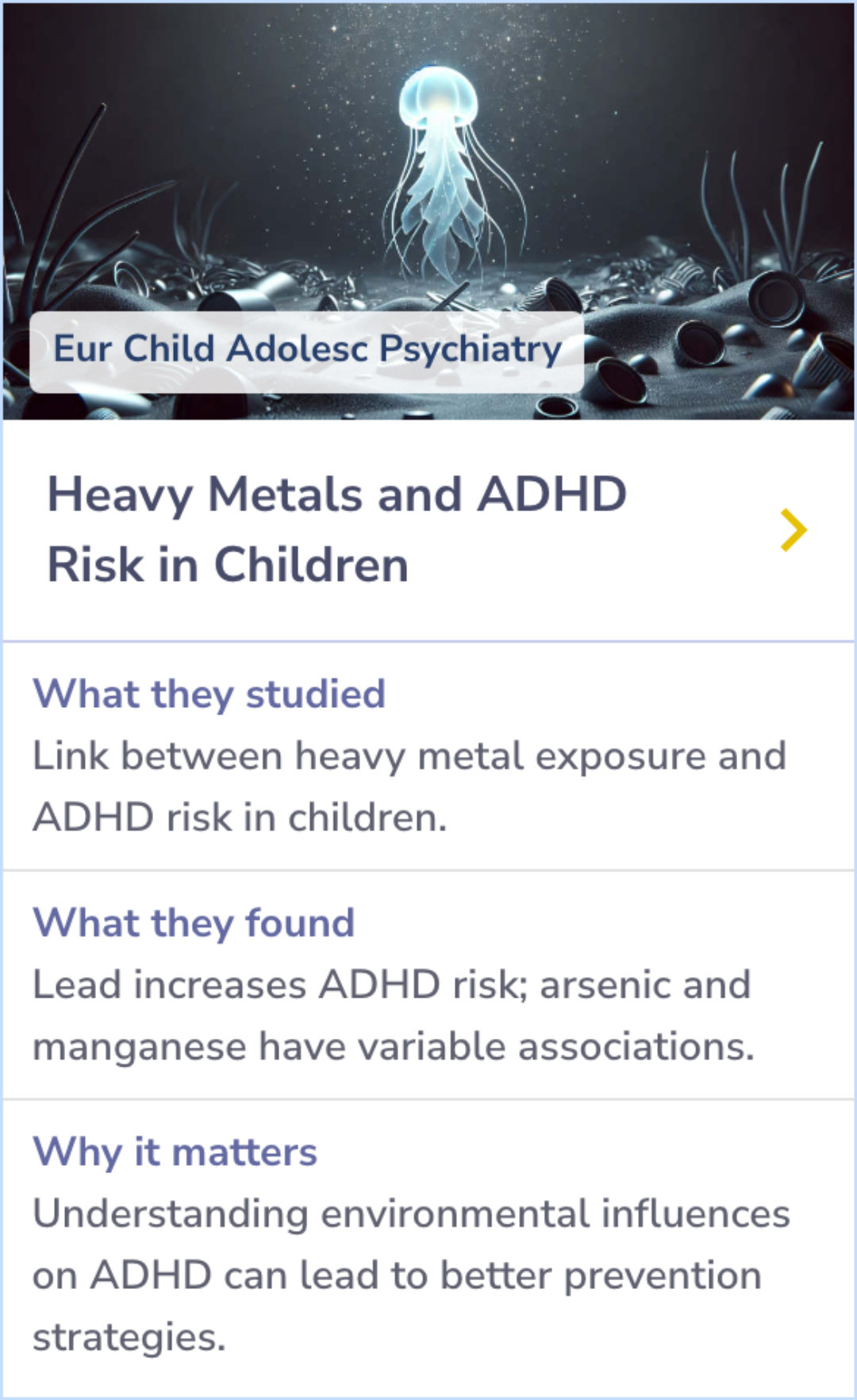
Clinical Guidelines
Guidelines suggest that behavioral therapy is the first-line treatment for preschool-aged children with ADHD, emphasizing evidence-based approaches like PTBM or classroom interventions.
Environmental exposures, such as lead and tobacco smoke, should be evaluated during psychosocial assessments for ADHD.
Stimulant medications can mildly raise heart rate and blood pressure, but some patients may experience significant increases, necessitating monitoring by clinicians.
Environmental exposures, such as lead and tobacco smoke, should be evaluated during psychosocial assessments for ADHD.
Stimulant medications can mildly raise heart rate and blood pressure, but some patients may experience significant increases, necessitating monitoring by clinicians.
Literature Review
Heng et al, 2022
Core Insight:Both papers explore the effects of heavy metals on children's neurodevelopment, specifically lead, arsenic, and manganese, but focus on different geographic regions and populations.
What It Adds:
Geographic focus: This paper emphasizes the impact in low- and middle-income countries, whereas the main paper is global, including diverse regions like the Americas.
Associations of mercury: The comparison paper notes mixed findings for mercury exposure, while the main paper found no significant association.
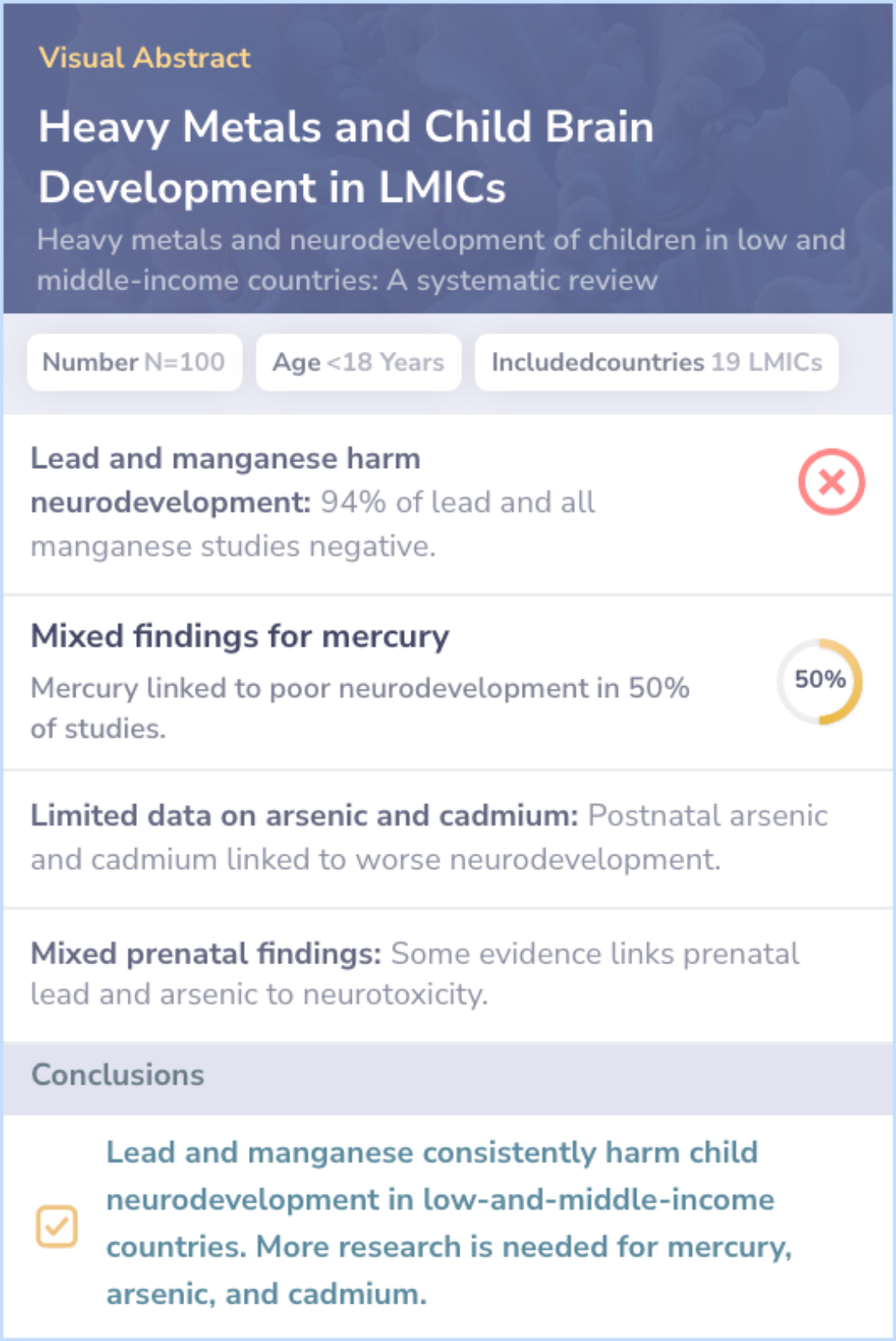
Literature Review
Lee et al, 2018
Core Insight:The main paper highlights lead, arsenic, and manganese as linked to ADHD risk, while the comparison paper identifies lead, cadmium, and antimony with ADHD symptoms and severity.
What It Adds:
Antimony and ADHD severity: This paper finds antimony levels linked to ADHD symptoms.
Cadmium's cognitive impact: Cadmium levels negatively affect intelligence scores.
Lead and symptom severity: Lead correlates with hyperactivity and inattention.
Shared Themes:
Lead linked to ADHD: Both papers associate lead exposure with ADHD symptoms.
Metal exposure and cognition: Both studies explore neurodevelopment and cognition.
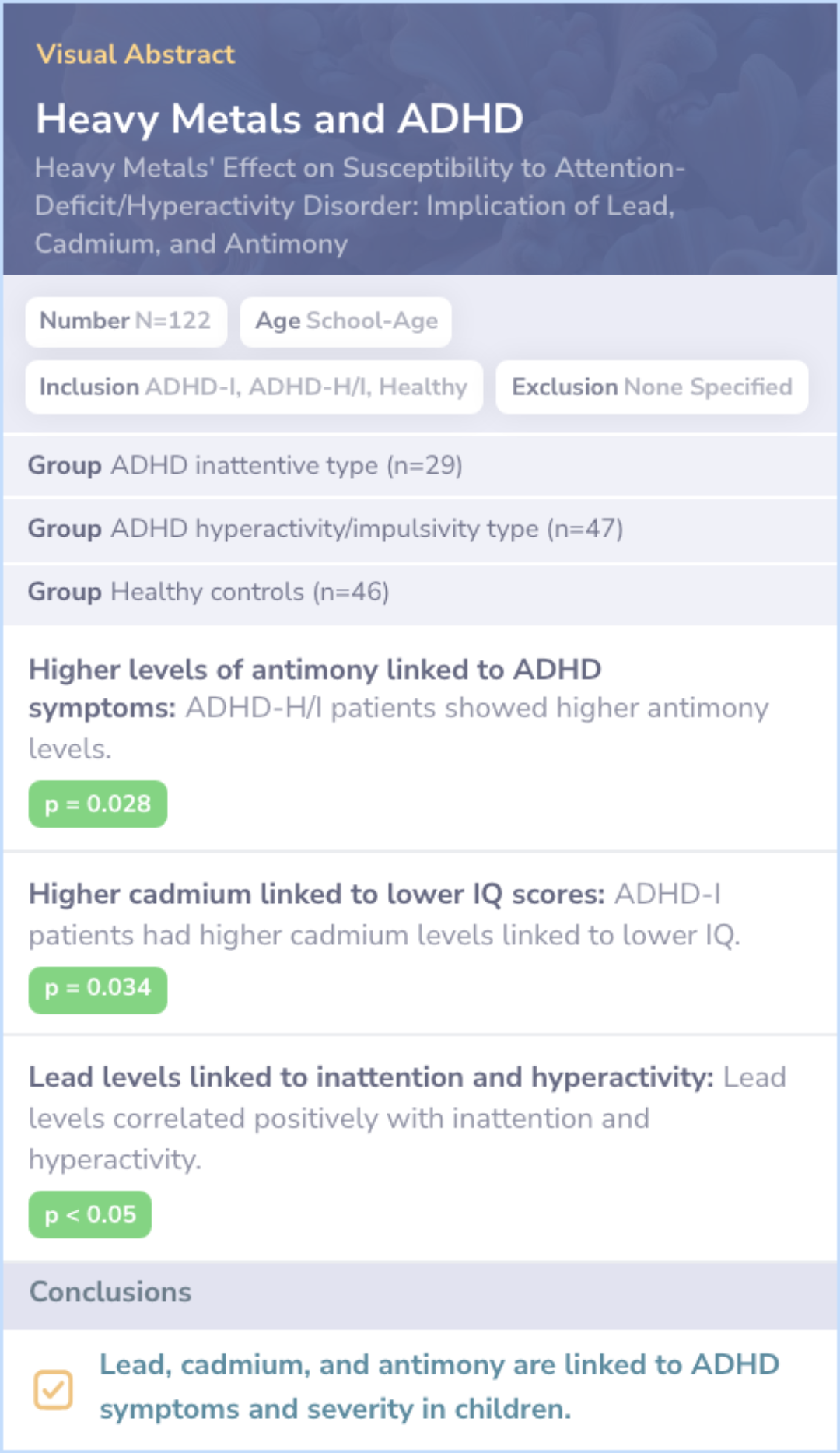
Literature Review
Farmani et al., 2024
Core Insight:The comparison paper confirms that lead exposure is associated with ADHD risk but finds no significant link with mercury exposure.
What It Adds:
Lead Exposure and ADHD: The comparison paper supports a link between lead exposure and ADHD, even at low levels.
Mercury Exposure Findings: Unlike the main paper, the comparison paper finds no significant association between mercury and ADHD.
